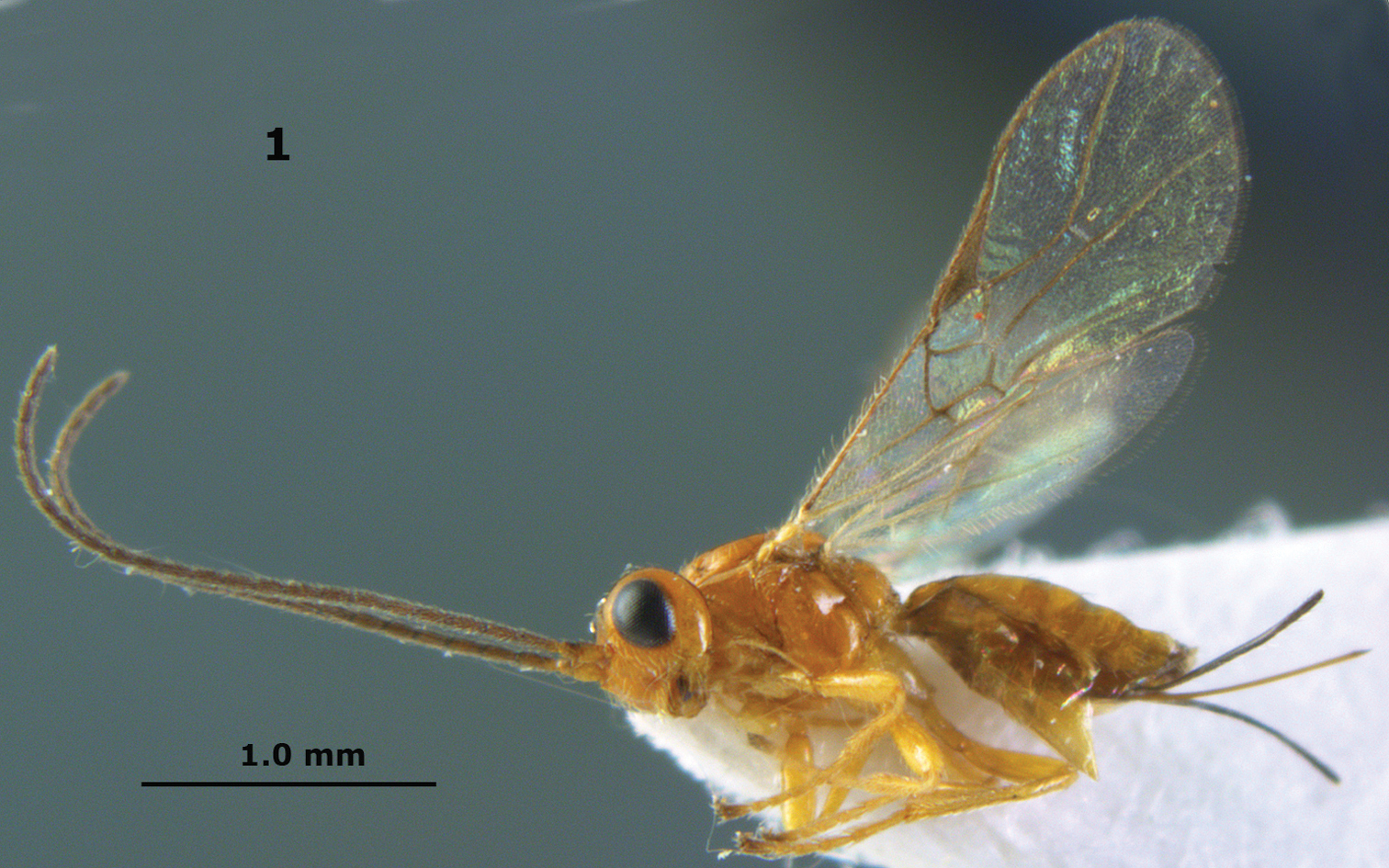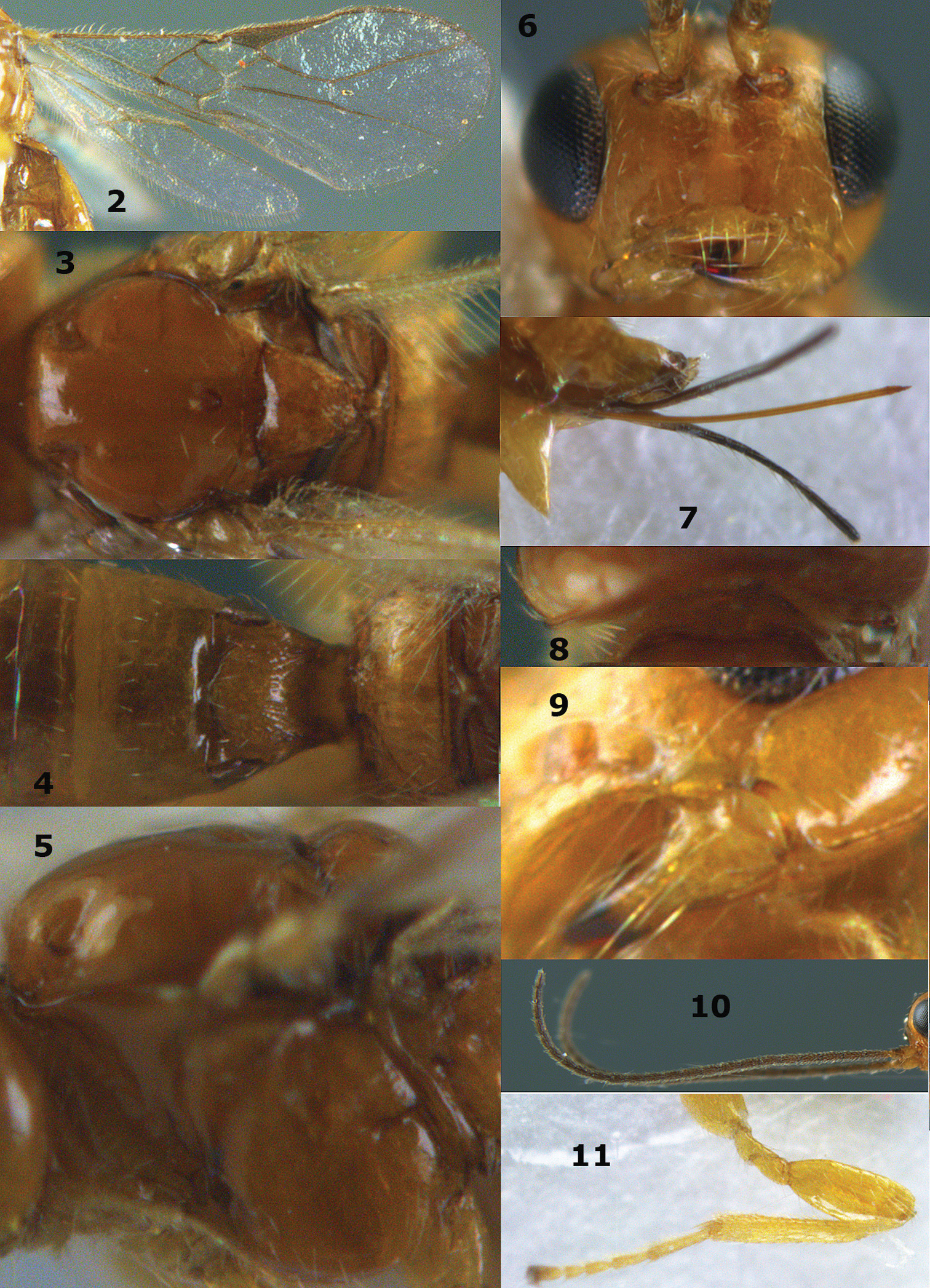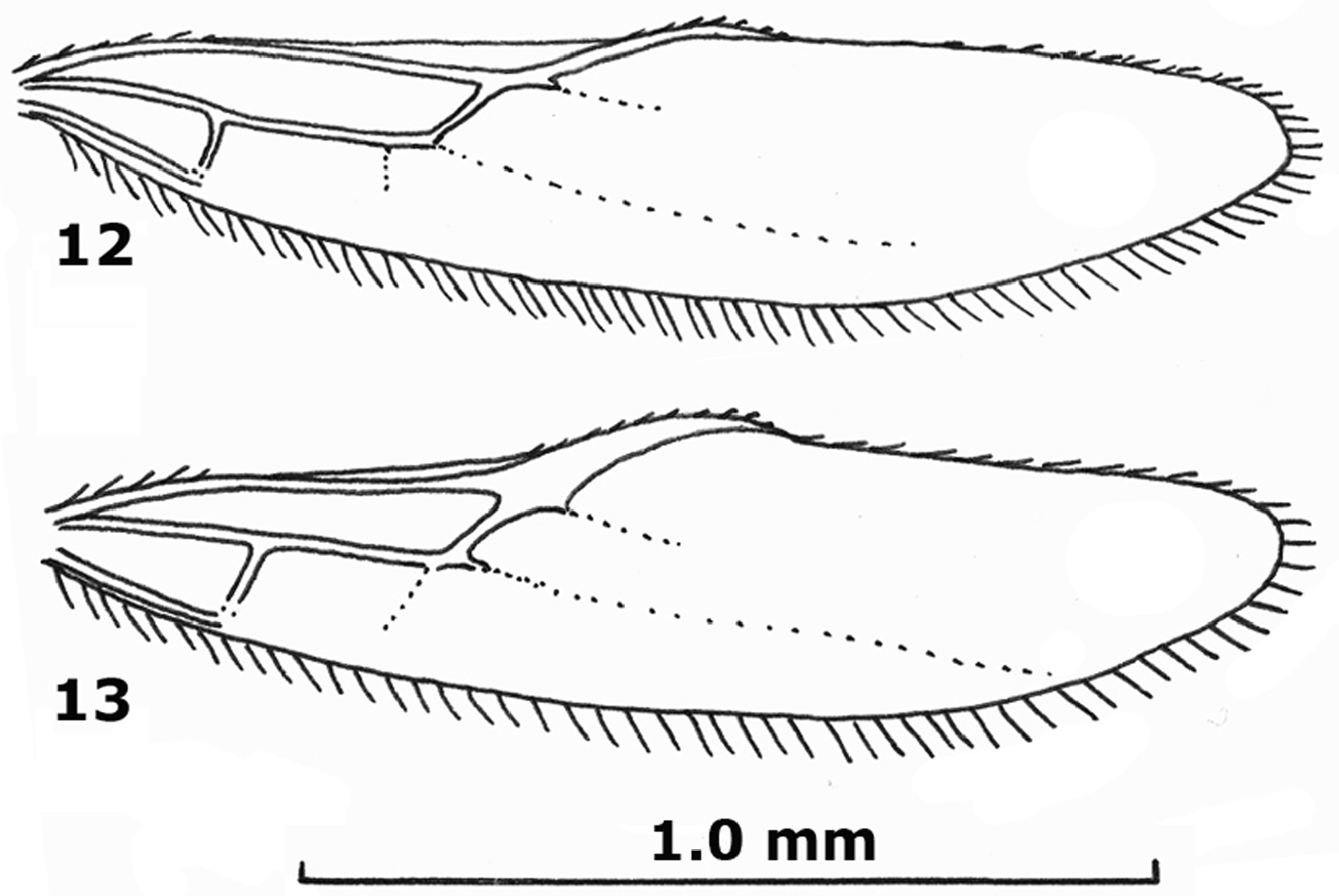






(C) 2012 Xi-Ying Li. This is an open access article distributed under the terms of the Creative Commons Attribution License 3.0 (CC-BY), which permits unrestricted use, distribution, and reproduction in any medium, provided the original author and source are credited.
For reference, use of the paginated PDF or printed version of this article is recommended.
Psyttoma gen. n. (type species: Opius latilabris Chen & Weng, 2005) from Shandong and Hubei (China) is described and illustrated (Hymenoptera: Braconidae: Opiinae). Psyttoma latilabris (Chen & Weng, 2005) and Psyttoma wachsmanni (Szépligeti, 1898) are new combinations.
Braconidae, Opiinae, Psyttoma, Psyttalia, new genus, Palaearctic, Oriental, China, Shandong, Hubei
The large subfamily Opiinae (Braconidae), with 1, 975 valid species according to
The first author collected some Opiinae for her revision of the Opiinae of Hunan in her home town in the province of Shandong (Palaearctic China). One of the species resembles members of the genus Psyttalia Walker, 1860, but does not fit well in this genus. Also DNA analysis in the DNA lab of the Naturalis Biodiversity Center (Leiden) showed that also the molecular data disagree with inclusion in the genera Psyttalia, Opius or Phaedrotoma. A combined analysis of the 16S and 28S sequences of about 50 mainly Oriental Opiine taxa from China and Malaysia was made and the results corroborated the view that the new genus has a separate position among the Opiine genera. The results of this study will be published elsewhere (
Opiinae are solitary koinobiont endoparasitoids of larvae of cyclorraphous Diptera, but oviposition may take place in the egg of the host (ovo-larval parasitoid). They may play an important role in the control of such dipterous pests as fruit-infesting Tephritidae and mining Agromyzidae. The parasitoid larva completes its final development when the host larva has made its puparium and the adult emerges from this puparium.
Material and methodsThe specimens were directly killed in 70% alcohol during collection. The redescribed specimens are deposited in the Naturalis collection (RMNH) at Leiden. For identification of the subfamily Opiinae, see
urn:lsid:zoobank.org:act:29FD6792-00E8-441F-9C72-E97458B50D3A
http://species-id.net/wiki/Psyttoma
Figures 1–13The name is a combination of the generic names Psyttalia Walker and Phaedrotoma Foerster, 1862, because it combines features of both genera. Gender: feminine.
Opius latilabris Chen & Weng, 2005.
Hypopygium of female distinctly acute apically and about 0.3 times as long as metasoma; labrum slanted backwards, leaving a large space below clypeus (Fig. 9); veins 2-SR+R and SC+R1 of hind wing of male strongly widened (Fig. 13); precoxal sulcus smooth; hind femur 2–3 times as long as wide (Fig. 11); hind tibia without carinula basally; scutellum convex medially and depressed medio-posteriorly, distinctly protruding above level of mesoscutum (Fig. 5); propodeum without median carina or areola; second metasomal segment 1.2 times longer than third tergite (Fig. 4); spiracle of second tergite distinctly removed from apex of first tergite (Fig. 4).
The genus will run in the key to world genera of Opiinae by
| 1 | Scutellum distinctly protruding above level of mesoscutum (Fig. 5); hypopygium of ♀ distinctly acute apically and about 0.3 times as long as metasoma (Fig. 7) and hind wing comparatively narrow (Figs 12, 13); hind femur very robust, 2-3 times as long as wide (Fig. 11); labrum slanted backwards, leaving a large space below clypeus (Fig. 9); medio-anterior veins of hind wing of male strongly widened (Fig. 13) | Psyttoma gen. n. |
| – | Scutellum at level of mesoscutum; hypopygium of ♀ variable, if distinctly acute apically and about 0.3 times as long as metasoma then hind wing moderately wide and hind femur slender, 4–5 times as long as wide; labrum normal, without large space below clypeus; medio-anterior veins of hind wing of male narrow | Psyttalia Walker and Phaedrotoma Foerster |
http://species-id.net/wiki/Psyttoma_latilabris
Figures 1–13Holotype (Beneficial Insects Laboratory, Fujian Agriculture and Forestry University, Fuzhou), ♀, “[China:], Hubei, Shennongjia, Honghua, 2.vi.1988, Zhang Li-qin”. Paratype: 1 ♂, “[China:], Hubei, Shennongjia, Yangriwan, 20.vi.1988, Yang Jian-quan”. The holotype has the head missing and the wing venation is bleached.
1 ♀ (RMNH), “N. China: Shandong, Anqiu, Suotou Mt., 31.vii.2009, c. 120 m, Li Xi-Ying, RMNH’09”, “CVA4245, sp. 11”; 1 ♂ (RMNH), same label data.
Clypeus narrow, 5 times as wide as high and 0.7 times as wide as face and face distinctly transverse (Fig. 6); pronope rather large and round; medio-posterior depression of mesoscutum medium-sized and round (Fig. 5); precoxal sulcus slightly impressed and smooth; scutellum rugulose medio-posteriorly; body completely brownish-yellow (Fig. 1).
Described from ♀ collected in Anqiu, length of body 2.0 mm, of fore wing 2.1 mm.
Head. Antenna with 25 segments and 1.2 times as long as fore wing; third segment 1.1 times as long as fourth segment, length of third, fourth and penultimate segments 3.5, 3.2 and 2.7 times their width, respectively; length of maxillary palp 0.9 times height of head; labial palp segments slender; labrum slanted backwards, leaving a large space below clypeus (Fig. 9); occipital carina widely removed from hypostomal carina and dorsally absent; hypostomal carina narrow; length of eye in dorsal view 2.1 times temple; frons slightly depressed behind antennal sockets, medially convex and glabrous, smooth; face smooth, medially weakly elevated; width of clypeus 5.0 times its maximum height and 0.7 times width of face; clypeus weakly convex, distinctly protruding forwards, punctate and its ventral margin thick and slightly concave; hypoclypeal depression wide and deep (Figs 6, 9); malar suture present; without punctures between malar suture and clypeus; mandible somewhat constricted medially and gradually widened baso-ventrally, with narrow ventral carina (Fig. 9), second tooth minute.
Mesosoma. Length of mesosoma 1.2 times its height; dorsal pronope large, round and pronotum oblique anteriorly (Fig. 8); pronotal sides smooth but oblique groove crenulate and posterior groove largely absent; epicnemial area smooth dorsally; precoxal sulcus medially superficially impressed, smooth as rest of mesopleuron; pleural sulcus smooth; mesosternal sulcus deep and narrow and very finely crenulate; notauli absent on disk, only anteriorly with pair of short smooth impressions; mesoscutum glabrous and strongly shiny; medio-posterior depression of mesoscutum medium-sized, deep, round; scutellar sulcus narrow and finely crenulate laterally, widened medially; scutellum convex medially, depressed and rugulose medio-posteriorly; surface of propodeum smooth, except for superficial rugulae posteriorly (Fig. 4).
Wings. Fore wing: pterostigma elongate triangular (Fig. 2); 1-R1 ending before wing apex and 1.4 times as long as pterostigma (Fig. 2); r:3-SR:SR1 = 3:27:55; 2-SR:3-SR:r-m = 15:27:7; r slender; 1-M slightly curved and SR1 straight; m-cu postfurcal; cu-a postfurcal and 1-CU1 widened; first subdiscal cell closed, CU1b short; apical third of M+CU1 sclerotized. Hind wing: M+CU:1-M:1r-m = 15:17:6; cu-a straight; m-cu present as faintly pigmented trace.
Legs. Length of femur, tibia and basitarsus of hind leg 2.3, 7.0 and 4.3 times as long as wide, respectively (Fig. 11); hind femur and tibia with medium-sized setae.
Metasoma. Length of first tergite equal to its apical width, its surface evenly moderately convex and rather densely longitudinally rugulose and dorsal carinae developed in basal 0.4 of tergite, straight (Fig. 4); second suture absent; second and following tergites smooth; length of setose part of ovipositor sheath 0.29 times fore wing, 2.7 times first tergite and equal to length of hind tibia; hypopygium distinctly acute apically and about 0.3 times as long as metasoma.
Colour. Brownish-yellow; antenna (but scapus yellowish), stemmaticum, ovipositor sheath, pterostigma and veins dark brown; palpi, mandible, tegulae and legs (but telotarsi darkened) pale yellow; wing membrane subhyaline.
Variation. Male from Anqiu has length of fore wing 2.0 mm, antenna with 24 segments, hind femur 3.0 times as long as wide and medio-anterior veins of hind wing strongly widened (Fig. 13).
Molecular data. 16S and 28S (CVA4245); GenBank Accession numbers JQ736254 and JQ736282, respectively.
China (Shandong, Hubei).
Unknown.
In the key by
In the key by
| 1 | Eye in dorsal view about twice as long as temple; vein CU1b of fore wing much shorter than vein 3-CU1 (Fig. 1); first tergite rather densely longitudinally rugulose (Fig. ); vein 1-R1 (= metacarp) about 1.4 times as long as pterostigma (Fig. 2); head dorsally, mesosternum, mesoscutal lobes medially, metanotum, propodeum, third and following metasomal tergites brownish-yellow (Fig. 1); East Palaearctic and North Oriental | Psyttoma latilabris (Chen & Weng, 2005) comb. n. |
| – | Eye in dorsal view about as long as temple; vein CU1b of fore wing somewhat shorter than vein 3-CU1; first tergite mainly coriaceous-punctate; vein 1-R1 slightly longer than pterostigma; head dorsally, mesosternum, mesoscutal lobes medially, metanotum, propodeum, third and following metasomal tergites black; West Palaearctic | Psyttoma wachsmanni (Szépligeti, 1898) comb. n. |
The specimens reported as Opius wachsmanni Szépligeti from the East Palaearctic region (Central Asia up to Korea) by
Psyttoma latilabris (Chen & Weng), female from Anqiu. Habitus lateral.
Psyttoma latilabris (Chen & Weng), female from Anqiu. 2 wings 3 mesosoma dorsal 4 propodeum and first-third metasomal tergites dorsal 5 mesoscutum and scutellum dorso-lateral 6 head anterior 7 ovipositor, sheath and hypopygium lateral 8 pronotum dorsal 9 mandible lateral 10 antenna 11 hind leg.
Psyttoma latilabris (Chen & Weng), female from Anqiu, but 13 male from Anqiu, hind wing. Scale-line: 12 1.0 ×, 13 1.1 ×.
The second author wishes to thank Prof. Dr Jia-hua Chen and Mr Min-lin Zheng, Beneficial InsectsLab., Fujian Agriculture and Forestry University, Fuzhou, Fujian, for their hospitality and for the possibility to examine the Opiine types.


